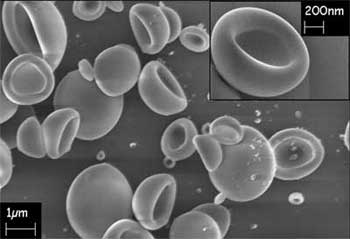| Posted: Feb 15, 2006 | ||
New nanocups may find potential use in drug delivery and filtration media |
||
| (Nanowerk News) A new fabrication technique involving an electrospray can create hemispherical nanocomposite cups with diameters as small as 50 nm. Researchers at Texas A&M University published their findings, titled "Fabrication of silica nanocomposite-cups using electrospraying" in the Feb. 10, 2006 edition of Nanotechnology. | ||
| Manufacturing organic nanoparticles using a self-assembly technique relies on the natural tendency of molecules to aggregate and form larger structures. Due to uniform crystal growth, the shape of these particles is always spherical. While the fabrication of non-spherical particles has been reported previously, the average diameter of these cup structures was in the micron scale. | ||
 |
Scanning electron microscope images of SiO2 cups with PVP (blended silica and polyvinylpyrrolidine solution) concentration. (Source: Texas A&M University) | |
| "We have been working on a new fabrication technique for creating hemi- spherical nanocomposite cups using electrospraying" Jun Kameoka, Assistant Professor in the Electrical Engineering Department at Texas A&M University told Nanowerk. "Cups with diameters as small as 50 nm were fabricated using the above technique. In addition, we have found that the ion concentration of polymer solution would be critical process parameters that can determine the morphology of these cups." | ||
| Kameoka's t technique involves using an electrospray, which evolved from the well known electrospinning technique, as well as calcination. This process can provide a very straight forward, highly efficient and very economical way to fabricate nanoscale composite structures. An electrostatic field forces the polymer jet from the electrospray source, and the continuous polymer jet splits into small individual droplets due to the surface tension of the solution and the electrostatic force. Then, the individual cups are formed in transit to the counter electrode. The morphology of the nanocups changed by varying the ionic concentration of the polymer solution. | ||
| This technique is very simple and highly efficient compared to other nanomaterial fabrication techniques such as self assembly of nanoparticles. The researchers also found that the diameter of the silica nanocups could be controlled by the PVP concentration. The lower the concentration of the polymer solution, the smaller the fabricated particles were. In addition, the morphology of the nanocups changed by adding ions into the polymer–sol–gel solution. A higher concentration of ions in the PVP solution resulted in the pore size becoming smaller and the shape becoming more spherical. These nanostructures may find uses in medical applications such as drug delivery, cancer treatment and other products such as cosmetics and dyes. | ||
 By
Michael
Berger
– Michael is author of three books by the Royal Society of Chemistry:
Nano-Society: Pushing the Boundaries of Technology,
Nanotechnology: The Future is Tiny, and
Nanoengineering: The Skills and Tools Making Technology Invisible
Copyright ©
Nanowerk LLC
By
Michael
Berger
– Michael is author of three books by the Royal Society of Chemistry:
Nano-Society: Pushing the Boundaries of Technology,
Nanotechnology: The Future is Tiny, and
Nanoengineering: The Skills and Tools Making Technology Invisible
Copyright ©
Nanowerk LLC
|
||
Become a Spotlight guest author! Join our large and growing group of guest contributors. Have you just published a scientific paper or have other exciting developments to share with the nanotechnology community? Here is how to publish on nanowerk.com.
